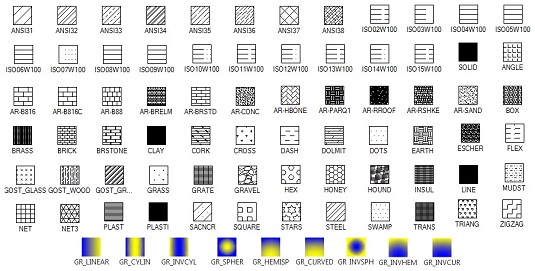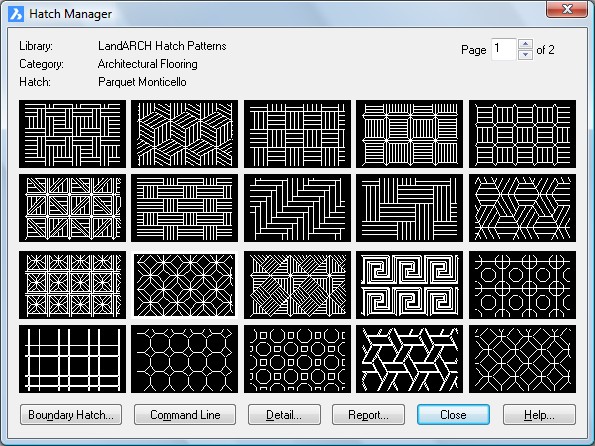

- #AUTOCAD HATCH PATTERNS HOW TO#
- #AUTOCAD HATCH PATTERNS CODE#
- #AUTOCAD HATCH PATTERNS SERIES#
- #AUTOCAD HATCH PATTERNS DOWNLOAD#
- #AUTOCAD HATCH PATTERNS WINDOWS#
Right-click a button in any toolbar, then select Customize in the popup menu The Toolbars dialog box opens.ģ.For your convenience, here is a list of sites containing free CAD hatch patterns that we have found useful:ĬAD Hatch - Why pay for hatch patterns? This site has more than 300 free hatch patterns to download organized into categories of wood, stonework, brick, roof tile, trees, gravel, vegetation and many other types of hatch patterns. If you haven’t done so already, load the Mymenu mnu file into the AutoCAD menu bar.Ģ. Try adding custom toolbars to the menu you created in the Adding Your Own Pull-Down Menu section.ġ.
#AUTOCAD HATCH PATTERNS HOW TO#
In the first part of this chapter you learned that you can create your own toolbars then you went on to learn how to create yow’ own menu. You may also use the Super Hatch Express tool discussed in Chapter 19. If you want to include thick lines in your hatch patterns you have to “build up” line widths with multiple line-type definitions. Autodesk managed to come up with 53 patterns and that was really only scratching the surface. This system of defining hatch patterns may seem somewhat limiting but you can actually do a lot with it. Line-group definition works exactly as in the line-type definitions you studied in the previous section. Positive values are line segments and negative values are blank segments. This value is equivalent to the value given when you create a line type. The last component is the actual description of the line pattern. In this example the duplication occurs 90° in relation to the line group because the x value is O.Figure 20.14. illustrates this point For a line oriented at a 45° angle the code 0.

125 indicates a precisely vertical direction.
#AUTOCAD HATCH PATTERNS CODE#
For a line oriented at a 0° angle, the code 0. It is not based on the drawing coordinates but on a coordinate system relative to the orientation of the line. This value is like a relative coordinate indicating x and y distances for a rectangular array. 12 (This determines the distance for arraying the line and in what direction as illustrated in Figure 20.13. If you have forgotten the numeric values for the various directions refer back to Figure 2.4 in Chapter 2 which shows AutoCAO’s system for specifying angles. It gives you a reference point to determine the location of other line groups involved in generating the pattern. This does not mean that the line actually begins at the drawing origin (see Figure 20.12).
#AUTOCAD HATCH PATTERNS SERIES#
This example shows a series of numbers separated by Commas it represents one line group. Each of these lines is duplicated in a fashion that makes the lines appear as boxes when they are combined. In the square pattern for instance two linesone horizontal and one vertical-are used.

A line group is a line of code much as a line type is defined.

A line group is like a line type that is arrayed a specified distance to fill the area to be hatched. Figure 20.10 shows the hatch pattern defined in the example.Ī pattern is made up of line groups. The first line determines the horizontal line component of the pattern and the second line represents the vertical component. Each line represents a line in the pattern. This example shows two lines of information. However the numbers in pattern descriptions have a different meaning. You can see some similarities between pattern descriptions and line-type descriptions. They both start with a line of descriptive text and then give numeric values defining the pattern. Here is one hatch pattern definition from that file:
#AUTOCAD HATCH PATTERNS WINDOWS#
This file can be opened and edited with a text editor that can handle ASCn files such as the Windows Notepad. The pattern definitions are contained in an external file named Acad. Unlike line types hatch patterns can not be created while you are in an AutoCAD file. This section demonstrates the basic elements of pattern definition. AutoCAD provides several predefined hatch patterns you can choose from (see Figure 20.9) but you can also create your own.


 0 kommentar(er)
0 kommentar(er)
